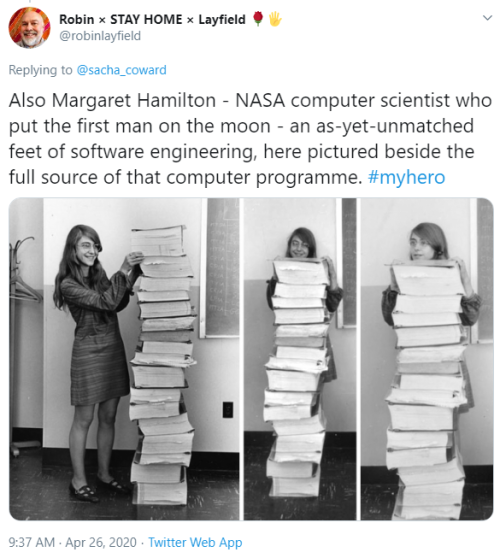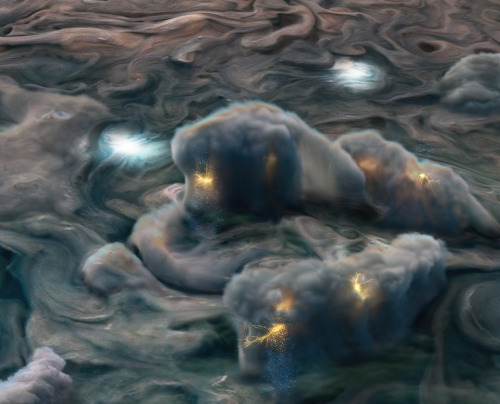“I Always Remember Having This Fight With A Random Dude Who Claimed That ‘straight White Men’ Were




“I always remember having this fight with a random dude who claimed that ‘straight white men’ were the only true innovators. His prime example for this was the computer… the computer… THE COMPUTER!!! THE COM-PU-TER!!!
Alan Turing - Gay man and ‘father of computing’ Wren operating Bombe - The code cracking computers of the 2nd world war were entirely run by women Katherine Johnson - African American NASA mathematician and ‘Human computer’ Ada Lovelace - arguably the 1st computer programmer”
- Sacha Coward
Also Margaret Hamilton - NASA computer scientist who put the first man on the moon - an as-yet-unmatched feet of software engineering, here pictured beside the full source of that computer programme. #myhero
Grace Hopper - the woman that coined the term “bug”
- @robinlayfield
More Posts from Science-child and Others

Our universe is FULL of strange and surprising things.
And luckily, our Hubble Space Telescope is there to be our window to the unimaginable! Hubble recently ran into an issue with its payload computer which controls and coordinates science instruments onboard the spacecraft. On July 16, teams successfully switched to backup hardware to compensate for the problem! A day later, the telescope resumed normal science operations. To celebrate, we’re taking you back to 2016 when our dear Hubble captured perhaps one of the most intriguing objects in our Milky Way galaxy: a massive star trapped inside a bubble! The star inside this Bubble Nebula burns a million times brighter than our Sun and produces powerful gaseous outflows that howl at more than four million miles per hour. Based on the rate the star is expending energy, scientists estimate in 10 to 20 million years it will explode as a supernova. And the bubble will succumb to a common fate: It’ll pop.
That's a wrap! Thank you all for the wonderful questions.
NASA Mars Perseverance Rover Mission Engineer Chloe Sackier answered questions about how we prepared for the mission, Perseverance’s entry, descent, and landing, and what Perseverance will do once on Mars.
Check out her full Answer Time for more: Career | Preparation | Entry, Descent, & Landing | Operation
We hope you had fun today and learned a little bit about our robotic astrobiologist landing on Mars on February 18th. You won't want to miss this! Tune in to NASA TV HERE starting at 2:15 p.m. EST.

If today’s Answer Time got you excited, team up with us to #CoutdownToMars! We created a virtual Mars photo booth, have sounds of Mars to listen to and more for all you Earthlings to channel your inner Martian. Check out ways to participate HERE.
Make sure to follow us on Tumblr for your regular dose of space: http://nasa.tumblr.com
What is the weirdest thing you had to account for when building the perseverance rover?
Roman’s Heat-Vision Eyes Are Complete!

Our Nancy Grace Roman Space Telescope team recently flight-certified all 24 of the detectors the mission needs. When Roman launches in the mid-2020s, the detectors will convert starlight into electrical signals, which will then be decoded into 300-megapixel images of huge patches of the sky. These images will help astronomers explore all kinds of things, from rogue planets and black holes to dark matter and dark energy.

Eighteen of the detectors will be used in Roman’s camera, while another six will be reserved as backups. Each detector has 16 million tiny pixels, so Roman’s images will be super sharp, like Hubble’s.

The image above shows one of Roman’s detectors compared to an entire cell phone camera, which looks tiny by comparison. The best modern cell phone cameras can provide around 12-megapixel images. Since Roman will have 18 detectors that have 16 million pixels each, the mission will capture 300-megapixel panoramas of space.
The combination of such crisp resolution and Roman’s huge view has never been possible on a space-based telescope before and will make the Nancy Grace Roman Space Telescope a powerful tool in the future.
Learn more about the Roman Space Telescope!
Make sure to follow us on Tumblr for your regular dose of space!
Hello!! Its wonderful to be able to ask questions, thank you!
About Perseverance, does it have a self-repair option? And as Curiosity is still operational, will they run missions together? Or will they split up to cover more distance?
Is this a sign that we're close to being able to set foot on Mars?
My final question is how do you receive the messages from such a long distance?
Thanks for all your hard work! 加油/Good luck!
“Is this a sign that we are close to being able to set foot on Mars?”

New results from our Juno mission suggest the planet is home to “shallow lightning.” An unexpected form of electrical discharge, shallow lightning comes from a unique ammonia-water solution.
It was previously thought that lightning on Jupiter was similar to Earth, forming only in thunderstorms where water exists in all its phases – ice, liquid, and gas. But flashes observed at altitudes too cold for pure liquid water to exist told a different story. This illustration uses data obtained by the mission to show what these high-altitude electrical storms look like.
Understanding the inner workings of Jupiter allows us to develop theories about atmospheres on other planets and exoplanets!
Illustration Credit: NASA/JPL-Caltech/SwRI/MSSS/Gerald Eichstädt/Heidi N. Becker/Koji Kuramura
Make sure to follow us on Tumblr for your regular dose of space: http://nasa.tumblr.com
How will the audio feed from Perseverance make its way back to Earth?
why are cheetahs not technically big cats? is it just because they're weird as hell or do they not meet some big cat criteria?
so the thing about Big Cats is that they’re all closely related members of the genus Panthera!

because they’re all part of the same lineage, they share a lot of traits like the ability to roar.
and cheetahs are actually members of a completely different cat lineage altogether, the genus Acinonyx!

they’re not very closely related to the big cats at all and are actually most closely related to Pumas, which you can totally see if you stack them up next to each other and squint really hard.


it’s okay though, the cheetah can still be the biggest cat in our hearts :’)
-
 hth38 reblogged this · 6 days ago
hth38 reblogged this · 6 days ago -
 nullians liked this · 6 days ago
nullians liked this · 6 days ago -
 sipral reblogged this · 1 week ago
sipral reblogged this · 1 week ago -
 shuffle776 liked this · 1 week ago
shuffle776 liked this · 1 week ago -
 cartoonlover87-2 liked this · 1 week ago
cartoonlover87-2 liked this · 1 week ago -
 stewy6702 reblogged this · 1 week ago
stewy6702 reblogged this · 1 week ago -
 stewy6702 liked this · 1 week ago
stewy6702 liked this · 1 week ago -
 chaosinsp reblogged this · 1 week ago
chaosinsp reblogged this · 1 week ago -
 smart-elec liked this · 1 week ago
smart-elec liked this · 1 week ago -
 wassailingreader reblogged this · 1 week ago
wassailingreader reblogged this · 1 week ago -
 imatimetraveler liked this · 2 weeks ago
imatimetraveler liked this · 2 weeks ago -
 crxwnedalex liked this · 2 weeks ago
crxwnedalex liked this · 2 weeks ago -
 scarrletmoon liked this · 2 weeks ago
scarrletmoon liked this · 2 weeks ago -
 plainoddboi reblogged this · 2 weeks ago
plainoddboi reblogged this · 2 weeks ago -
 crazycrookedangelicimmortal reblogged this · 2 weeks ago
crazycrookedangelicimmortal reblogged this · 2 weeks ago -
 crazycrookedangelicimmortal liked this · 2 weeks ago
crazycrookedangelicimmortal liked this · 2 weeks ago -
 luna06k liked this · 2 weeks ago
luna06k liked this · 2 weeks ago -
 temporalschism reblogged this · 2 weeks ago
temporalschism reblogged this · 2 weeks ago -
 nestingbluebird reblogged this · 2 weeks ago
nestingbluebird reblogged this · 2 weeks ago -
 artofsen liked this · 2 weeks ago
artofsen liked this · 2 weeks ago -
 nianna reblogged this · 2 weeks ago
nianna reblogged this · 2 weeks ago -
 astroslxts liked this · 3 weeks ago
astroslxts liked this · 3 weeks ago -
 imaed reblogged this · 3 weeks ago
imaed reblogged this · 3 weeks ago -
 local-shitty-cryptid reblogged this · 3 weeks ago
local-shitty-cryptid reblogged this · 3 weeks ago -
 godsneopronouns reblogged this · 3 weeks ago
godsneopronouns reblogged this · 3 weeks ago -
 trademarkhubris reblogged this · 3 weeks ago
trademarkhubris reblogged this · 3 weeks ago -
 troubleteenstuff liked this · 3 weeks ago
troubleteenstuff liked this · 3 weeks ago -
 none-beef reblogged this · 3 weeks ago
none-beef reblogged this · 3 weeks ago -
 possessesnightshift reblogged this · 3 weeks ago
possessesnightshift reblogged this · 3 weeks ago -
 satanistsparklingunicorn reblogged this · 3 weeks ago
satanistsparklingunicorn reblogged this · 3 weeks ago -
 jazforthesoul liked this · 3 weeks ago
jazforthesoul liked this · 3 weeks ago -
 transmasciero reblogged this · 3 weeks ago
transmasciero reblogged this · 3 weeks ago -
 dangitdunsparce liked this · 3 weeks ago
dangitdunsparce liked this · 3 weeks ago -
 culturally-deviant reblogged this · 3 weeks ago
culturally-deviant reblogged this · 3 weeks ago -
 drygreysocks liked this · 3 weeks ago
drygreysocks liked this · 3 weeks ago -
 halsaph reblogged this · 3 weeks ago
halsaph reblogged this · 3 weeks ago -
 spidori reblogged this · 3 weeks ago
spidori reblogged this · 3 weeks ago -
 liketolaugh-misc reblogged this · 3 weeks ago
liketolaugh-misc reblogged this · 3 weeks ago -
 surfsup2007 liked this · 3 weeks ago
surfsup2007 liked this · 3 weeks ago -
 pyro-raccoon reblogged this · 3 weeks ago
pyro-raccoon reblogged this · 3 weeks ago -
 enokito reblogged this · 3 weeks ago
enokito reblogged this · 3 weeks ago -
 enokito liked this · 3 weeks ago
enokito liked this · 3 weeks ago -
 dontcallmebugaboo liked this · 3 weeks ago
dontcallmebugaboo liked this · 3 weeks ago -
 sheepheadfred reblogged this · 3 weeks ago
sheepheadfred reblogged this · 3 weeks ago -
 warningmastertc reblogged this · 4 weeks ago
warningmastertc reblogged this · 4 weeks ago -
 korora12 reblogged this · 4 weeks ago
korora12 reblogged this · 4 weeks ago -
 korora12 liked this · 4 weeks ago
korora12 liked this · 4 weeks ago

